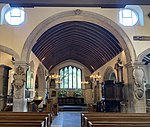Crosby Hall, London

Crosby Hall is a historic building in London. The Great Hall was built in 1466 and originally known as Crosby Place in Bishopsgate, in the City of London. It was moved in 1910 to its present site in Cheyne Walk, Chelsea. It now forms part of a private residence, which in 2021 was renamed Crosby Moran Hall.The Great Hall, and additional work of 1910 and 1925–1926, are listed Grade II*. Although fragmentary and not on its original site, this is the only example of a medieval City merchant house surviving in London. Between 1988 and 2021 it was restored, and further buildings added, to create the present complex. The Great Hall is considered to be the most important surviving secular domestic medieval building in London.
Excerpt from the Wikipedia article Crosby Hall, London (License: CC BY-SA 3.0, Authors, Images).Crosby Hall, London
Cheyne Walk, London World's End (Royal Borough of Kensington and Chelsea)
Geographical coordinates (GPS) Address External links Nearby Places Show on map
Geographical coordinates (GPS)
| Latitude | Longitude |
|---|---|
| N 51.482483333333 ° | E -0.17264444444444 ° |
Address
Crosby Moran Hall
Cheyne Walk
SW3 5AZ London, World's End (Royal Borough of Kensington and Chelsea)
England, United Kingdom
Open on Google Maps










